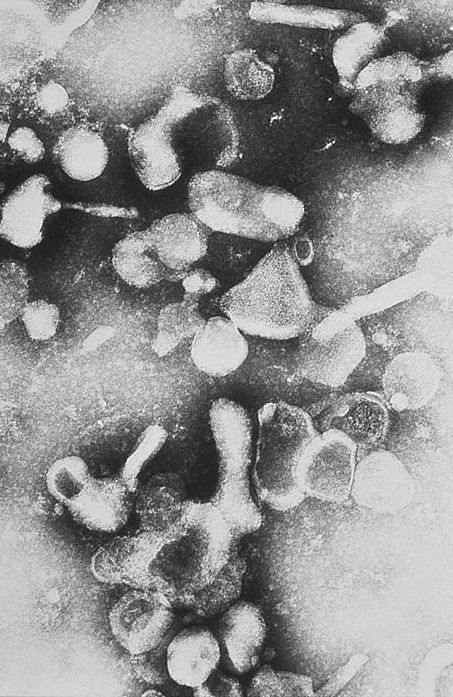|
|
| (14 intermediate revisions by 2 users not shown) |
| Line 1: |
Line 1: |
| | + | {{frontpage |
| | + | |pagetitle =Retroviridae |
| | + | |pagebody = Retroviruses are persistent, non-cytopathic, systemic viruses that give rise to secondary disease, such as tumors, immune-complex disease, or immunosuppression. |
| | + | |contenttitle =Content |
| | + | |contentbody =<big><b> |
| | | | |
| | + | <categorytree mode=pages>Retroviridae</categorytree> |
| | | | |
| − | [[File:FeLV logo.jpg]]
| + | |logo =FeLV logo.jpg |
| | + | }} |
| | | | |
| | + | {{Learning |Vetstream = <p>[https://www.vetstream.com/felis/Content/Bug/bug60015.asp Feline Immunodeficiency Virus]</p><p>[https://www.vetstream.com/felis/Content/Bug/bug60014.asp Feline Leukemia Virus]</p>}} |
| | | | |
| − | =Introduction=
| |
| − | Retroviruses are persistent, non-cytopathic, systemic viruses that give rise to secondary disease, such as tumors, immune-complex disease, or immunosuppression.
| |
| | | | |
| − | =Morphology=
| |
| − | *Fragile, enveloped RNA viruses with roughly spherical spike proteins
| |
| − | *Genome has 3 genes:
| |
| − | **''gag'': group-specific antigen coding gene, encodes capsid proteins
| |
| − | **''pol'': encodes reverse transcriptase (RT) and integrase
| |
| − | **''env'': encodes envelope spikes, and can be used in diagnosis and subunit vaccines
| |
| − | *Both ends of genome show a promoter (LTR: long terminal repeat)
| |
| | | | |
| − | =Antigenicity=
| + | [[Category:Viral Organisms]] |
| − | *Group-specific antigens (gag's) are shared by all isolates of each virus
| + | [[Category:To_Do_-_Clinical/Viruses]] |
| − | **This can be exploited by diagnostic tests
| |
| − | *Lentiviruses show variation by mutation, making vaccination difficult
| |
| − | | |
| − | =Virulence and Pathogenesis=
| |
| − | *Replication involves integrating into the host cell genome:
| |
| − | **'''Uncoating''' to release RNA and RT
| |
| − | **+RNA '''transcribed''' to -DNA by RT
| |
| − | **-DNA becomes circular dsDNA and is '''integrated''' into host chromosome by integrase
| |
| − | **DNA '''codes''' for viral proteins using cellular organelles and enzymes
| |
| − | **Because of this technique, virus replication is much '''slower''', and retroviruses can remain '''latent'''
| |
| − | *Tumor production takes 2 forms:
| |
| − | **Viruses can carry oncogenes within their genome --> tumor production occurs quickly
| |
| − | **Insertion of the viral LTR switches on proto-oncogenes in the host cell genome --> tumor production can take years
| |
| − | | |
| − | =Types and Subtypes=
| |
| − | 7 Genera, including these of veterinary relevance:
| |
| − | #[[Mammalian Type C retrovirus]]
| |
| − | | |
| − | #Mammalian Type D retrovirus
| |
| − | #*[[Sheep Pulmonary Adenomatosis]]
| |
| − | #Avian Type C retrovirus
| |
| − | #*[[Avian Leukosis Virus]]
| |
| − | #Spumavirus
| |
| − | #*Feline and bovine syncitial viruses (common, nonpathogenic)
| |
| − | #BLV-HTLV retroviruses
| |
| − | #*Bovine Leukosis Virus
| |
| − | #Lentiviruses
| |
| − | #*[[Feline Immunodeficiency Virus (FIV)]]
| |
| − | #*Bovine Immunodeficiency Virus
| |
| − | #*[[Visna-Maedi Virus of Sheep]]
| |
| − | #*[[Caprine Arthrirtis Encephalitis Virus]]
| |
| − | #*[[Equine Infectious Anemia]]
| |
| − | #*Jembrana of Bali cattle
| |
| − | #*Human Immunodeficiency Virus (HIV)
| |
| − | [[Category:Viruses]] | |
